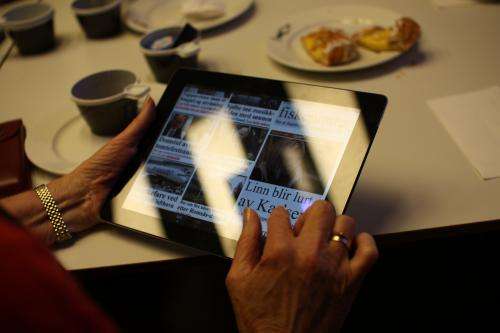Helping to reduce hospital admissions for COPD patients

Patients can use tablet computers to report their daily condition. Hospitals can pick up early symptoms, take action and thereby reduce admissions.
Product designer Jarl Reitan and his colleague Silje Bøthun are working on a preventative project for patients with advanced COPD. Five patients from Trondheim are currently testing a system using tablet computers and a customised app developed by SINTEF.
"The aim is to achieve a closer dialogue between the patient and the support services, prevent sudden dips in the patient's medical condition and exacerbations of the disease".
Digital reporting
Using the app, patients submit a simple daily report to St. Olav's Hospital, which receives the data about their current condition. Patients describe their general daily condition using simple, self-explanatory response options such as "good" or "bad". They can also telephone the monitoring centre from their tablet if they need to talk to someone.
The municipality is also working on setting up an emergency medical centre to act as a call centre for the chronically ill. This centre will collect all the data reported by patients from their own homes, and will be able to follow up any patients that require attention. Since patients report their condition on a daily basis, and these data are analysed by the medical centre, patients do not need to worry that any exacerbations will not be picked up.
Repeated hospitalisations
At the moment, COPD patients require frequent hospitalisations.
Clinic Manager Anne Hildur Henriksen of the Clinic for Thoracic Medicine at St. Olav's Hospital says that many patients with advanced COPD end up in hospital because of an acute exacerbation of their condition. She refers to a Scandinavian study which found that the average length of stay of these patients was 8.6 days each time, and that 13% of the patients are admitted more than twice a year.
Tablet is the right medium
The tablet computer was chosen as a medium because the tool is not associated with a stigma, and has many different applications. Many of the current aids send the opposite signal; with their large buttons and unusual design, they stand out in a patient's living room. Tablets can be used by grandchildren when they come to visit, and the idea is also for the tablet to provide access to written information, videos and tutorials for patients.
"Providing the user with knowledge about the disease is a major part of the project, and will be incorporated into any future system. We want to help people with COPD to learn about their own disease – this will give them a better overview and more control", explains Silje Bøthun. "That is why it is important for the patients to use the media over an extended period. We have loaded the tablets with games like cabal, and received enquiries about Facebook and yr.no. We also have to make the app interesting enough that people will use it".
What information is required?
The next step for the researchers is to work with the company Imatis to improve the technical aspects of the product, and to work with the users to improve its content.
"We need to find out what the patients think about the reporting tool, so that we can evaluate it. We are also working closely with the hospitals and municipalities, to find out what THEY need to know. The information that the patients need to pass on is not necessarily the same as that required by the hospital", says Bøthun.
COPD patients currently report to the specialist health services or hospital, but the municipalities will soon be taking over this service.
Jarl Reitan believes that the municipalities probably do not have the expertise required to be able to make decisions about any action that may be needed, and that the new scheme will require good communication between the municipality and the hospital. "The municipalities' emergency medical centres can share the computer screen with the hospitals if they need to, and staff there can examine the material in more detail and determine what treatment may be needed", he says.
Municipalities are interested
At the moment, the municipalities of Trondheim and Bærum are leading the way in testing out this welfare technology, but Stavanger has also joined in – and "border" municipalities such as Bergen and Kristiansand think that the project is interesting and would like to be part of it at a later stage.
The idea is for patients' data to be made easily available to their doctors and to the hospitals' lung departments. This will enable them to more actively monitor the course of their patients' disease, and will give them more options for communication and inter-departmental resource utilisation.
"Communication between patients and the health services is a problem that is not just limited to people with COPD. This project has therefore received a great deal of attention, and we were recently mentioned in a new Report to the Storting", relates Jarl Reitan of SINTEF.
More information: gemini.no/2007/03/kampen-mot-kols/













